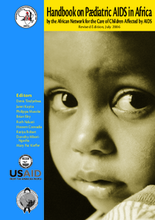HIV/AIDS is a major cause of infant and childhood mortality and morbidity in Africa. In children under five years of age, HIV/AIDS now accounts for 7.7% of mortality worldwide. AIDS already accounts for a rise of more than 19% in infant mortality and a 36% rise in under five mortality. Together with factors such as declining immunisation, HIV/AIDS is threatening recent gains in infant and child survival and health.
Yet, for the most part, HIV infection in children is preventable. In industrialised countries in North America and Europe, paediatric HIV infection has largely been controlled. In these settings, HIV testing as part of routine antenatal care, combinations of antiretroviral (ARV) drug regimens, elective caesarean section, and complete avoidance of breast-feeding have translated into mother-to-child transmission (MTCT) rates of less than 2%. In Africa, on the other hand, high rates of maternal HIV infection, high birth rates, lack of access to currently available and feasible interventions, and the widespread practice of prolonged breast-feeding translate into a high burden of paediatric HIV disease. The transmission risk for a child born to an HIV-infected mother in an African setting without interventions for prevention of mother-to-child transmission (PMTCT) is about 30–40%. The other 60–70% of children, although not HIV-infected, still have a 2- to 5-fold risk of mortality as a direct consequence of the mother’s HIV disease, when compared to children born to uninfected mothers.
Collectively, we have the best opportunity to date of making an impact on the paediatric HIV epidemic. There is international will and commitment (for example, WHO’s 3 by 5 initiative, the Global Fund for AIDS, TB and Malaria, and the U.S. government’s Presidential Emergency Plan for AIDS Relief) to rapidly expand programmes for identifying HIV-infected adults through voluntary counselling and testing (VCT), preventing mother-to-child transmission of HIV, preventing and treating opportunistic infections (OIs) and other common HIV-related conditions, and providing antiretroviral therapy (ART) to those who need it. We must exploit these efforts fully to benefit both adults and children with HIV infection and disease by implementing child- and family-centred care and treatment services. Furthermore, the impact of maternal HIV disease on childhood morbidity and mortality means also addressing parental health, in order to have a meaningful impact on child health and well-being. As national efforts to expand access to HIV prevention, care, and treatment continue, opportunities will increase to identify other at-risk (including HIV-exposed infants) and infected family members.
While there are many books about HIV/AIDS in Africa, they contain little in the way of practical experiences, insights, or guidelines about the care of children. Most paediatric HIV handbooks are from developed countries and are, therefore, less relevant for practitioners in resource-constrained African settings. We recognise that Africa is not homogeneous—in infrastructure or resources—but our hope is that this handbook will provide users in various countries with a resource that can be adapted to meet their specific needs.
©African Network for the Care of Children Affected by AIDS (ANECCA)

